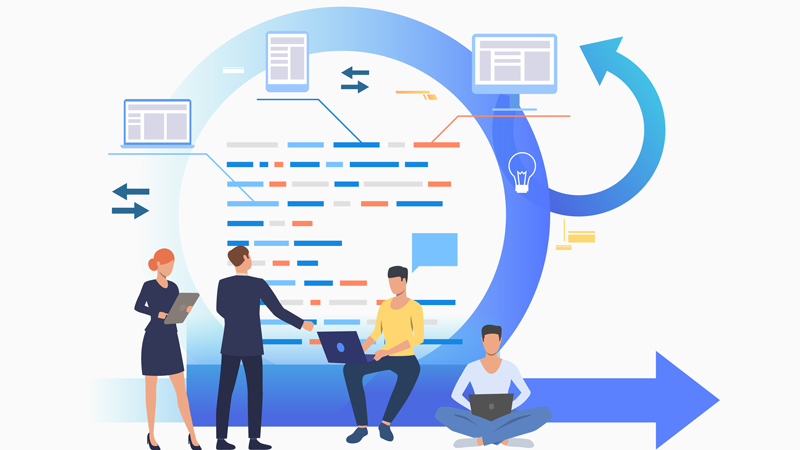
No transition from milestone-driven work to Agile project management is without its challenges. The Agile methodology is known for empowering teams to work more efficiently and effectively, but these results seldom happen overnight. That’s because making the switch to Agile project management isn’t a one-time action, it’s a journey that requires the support of executives, management, and workers. When applied effectively, however, Agile can dramatically improve the way your organization delivers value.
Here are five tips that can help make your transition as smooth as possible.
1. Secure executive sponsorship
Agile project management isn’t just a method of completing tasks; it’s an entire philosophy that looks at how to manage, plan, and execute them. It’s important to make that distinction, because it can be significantly harder to make the switch to Agile project management for people who are used to milestone-driven work.
Some employees that are set in their ways take the “if it’s not broke, don’t fix it” philosophy, others just need some extra time learning how to get used to the Agile approach. If you’re in charge of bringing Agile to your department, you’ll likely encounter both of these types. That’s why it’s important for you to have an executive sponsor who can help you along the way.
Arguably the biggest difficulty you’ll face when undertaking Agile project management is the initial jump from milestone-driven planning to iterative planning. It’s during this time when teams need sponsorship from a department head or executive who is able to support teams as they learn how to adopt the Agile approach.
Some of the duties of an executive sponsor include:
- Establishing guardrails to ensure that Agile project management is aligned with organizational goals and desired outcomes
- Ensuring teams transitioning to Agile have adequate support and resources
- Planning a clear-cut transformation strategy to help teams as they move to Agile project management or a hybrid system
A good executive sponsor supports Agile teams as they’re still learning from one another, giving them the chance to overcome hurdles and learn how to plan and deliver iterative work more effectively.
2. Create fixed, cross-functional teams
One of the first things you’ll notice when making the switch from milestone-driven work to Agile project management is how teams differ. Agile teams are:
- Fixed: The same group of people work together for an extended period of time
- Coordinated: Agile works best with small or mid-sized teams that can communicate and collaborate more efficiently
- Cross-functional: Members from different departments are assigned to an Agile team, allowing for people with different skillsets to lend their expertise
Leadership is also different under Agile project management. Management adopts a hands-off approach, giving Agile teams the autonomy to define their own work. Under this approach, Agile leaders are responsible for:
- Helping teams reach and maintain agility
- Setting the project goals and objectives
It’s the Agile team’s job to define their work in a way that helps the organization reach those goals and objectives. This is why fixed teams are an essential part of good Agile project management. Members need time to work together and learn their strengths and weaknesses, their turnaround time, and any other important information that is needed to make informed decisions when planning.
Team autonomy is also linked to higher levels of motivation. As teams start planning and delivering their own work, a greater sense of accountability and ownership starts to develop. This is especially true for teams using a Kanban board, where they can see who’s been assigned work and the status of that work.
Of course, you’ll probably encounter new Agile teams that aren’t hitting their deadlines from time to time. This doesn’t necessarily mean that the team isn’t suited for the Agile approach; they might just need some time to adjust. Consider limiting the amount of work they take in until they can hit their deadlines. Then start allowing them to take on more work once they feel confident using Agile.
3. Consider adopting a hybrid approach
Remember, the hardest part of Agile is taking the initial step. Managers and stakeholders who’re used to milestone-driven work may not understand how Agile project management works and could make decisions that disrupt Agility, like constantly moving people from one team to another or limiting team autonomy.
If your organization isn’t ready to jump head-first into Agile, what do you do? Consider starting with a hybrid approach so stakeholders can see the value Agile brings to the organization, then you can make a smooth transition from milestone-driven work to Agile project management in your own time.
A hybrid model is especially useful for teams working with an executive sponsor with a “waterfall mindset.” Under this approach, you can have your teams complete iterative work using a Kanban board, while having the manager report the progress back to the stakeholders using Gantt charts so it’s easier for them to understand how work is being delivered.
Some project management platforms have built-in templates for hybrid work, which makes it even easier to switch your teams over from Waterfall to iterative work.
4. Plan at a higher level
If you’re going for a hybrid approach, how do you reconcile the hierarchal nature of Waterfall with the importance of team autonomy under the Agile approach? While it may seem like these two ideologies clash, they can coexist without undermining productivity and efficiency. Let planning take place at the top level; stakeholders can decide what tasks need to get done, while also giving teams the autonomy to determine how to deliver their work.
5. Consistently measure team progress
Iterative work needs feedback to be successful, especially in the early stages when teams are just getting to know what they are and aren’t capable of. Adopting a data-driven approach will help minimize friction as you make the transition to Agile project management. Here are some KPIs you can use to measure the progress of your Agile teams:
- Flow of work: Looks at whether your team is able to keep work consistently moving through their processes
- Cycle time: Shows how quickly your team is producing value
- Burn-down: Looks at how efficient your team is at completing work
- Burn-up: How much work is completed compared to the total amount of work of an iteration
- Cumulative flow chart: How much work is in each problem
On top of that, working in iterative chunks gives you the chance to measure performance much more quickly than you would if you were working with milestones. This makes it easier to identify and correct constraints before they snowball into bigger problems.
Getting the most out of your Agile journey
Making the shift to Agile project management isn’t without its challenges. While this isn’t an essential step, you may want to consider hiring an Agile coach who can help with the transition. An Agile coach can guide your organization as it moves through the five steps mentioned above, while also ensuring that the company continues to promote the Agile mindset throughout all levels within the organization.
If you’d like to learn more about switching from milestone-driven work to Agile project management, watch our webinar called “Agile or Waterfall – Choose the Right Methodology for Success.”





